-
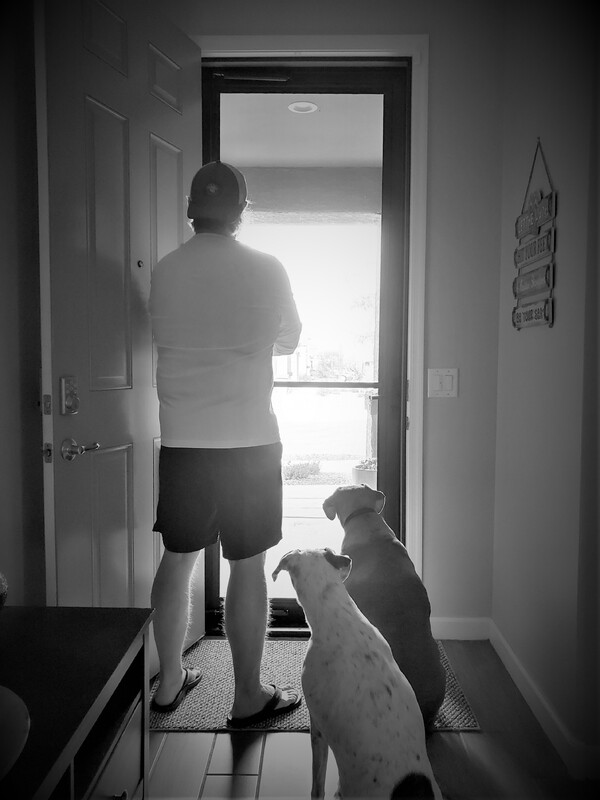
2021-04-21
--Reflections on the Pandemic Archive--
Looking back over my experience with the “Journal of the Plague Year” COVID-19 archive, my prevailing emotion is gratitude. This opportunity granted me experience that few historians earn, and the remote, asynchronous work schedule allowed me to collaborate with my colleagues in ways that maximized our respective contributions. The breadth and depth of our individual experiences and perspectives tremendously improved our collective process and products.
I spent enough time in the Arizona State Archives last year to recognize such collections as historical treasure chests, but I have now participated in processing an archive’s content and navigating the ethical dilemmas those submissions sometimes create. Archivists and curators are the history profession’s truly unsung heroes, and their work facilitates society’s perception of itself.
My background in police work and public safety drew me to the archive’s existing Law Enforcement collection. In taking on that subset, I succeeded in reshaping the collection’s parameters to now include stories about police and law enforcement. I wanted to diversify the collection to encompass perspective of both the police and the public with whom they interact and serve. While some overlap exists between the Law Enforcement and Social Justice collections, each remains distinct. Through my contacts and writing, I promoted a Call for Submissions to an international audience of law enforcement professionals to reduce their relative silence within the archive.
Within the archive’s content, I recognized that one’s location might shape their pandemic experience, and I created and designed an Arizona-based exhibit to explore that. Further research and discussion with my mentors and colleagues ensured the exhibit illustrated these differences without excluding visitors whose diverse experiences could further enrich the archived and exhibited content. I am proud of my “Arizona’s COVID-19 Pandemics” exhibit, particularly because of its compressed, one-month incubation period. Beyond displaying images, data, and stories representative of the diverse pandemic experiences within the state, the ACP exhibit offers visitors numerous levels of interaction and engagement to became active participants and create their own exhibit experience. Visitors can complete opinion surveys, add a story to the archive, explore additional content related to the displayed pieces, view ever-changing results from pre-defined archival content searches, conduct their own archival search, view collective visitor survey results, and apply to join the staff. The exhibit’s searches will include the archive’s future submissions, which reshapes both the exhibit and the experience visitors may have with it.
A more detailed explanation of my ACP exhibit may be reviewed here: https://covid-19archive.org/s/archive/item/43037
Because of Dr. Kathleen Kole de Peralta and Dr. Mark Tebeau, I stand prepared to join research, curation, and exhibition teams and immediately contribute to their work products.
Despite my gratitude for this experience and the opportunities it presented, I look forward to the day COVID-19 is no longer part of humanity’s daily vernacular.
James Rayroux
22 April 2021
-
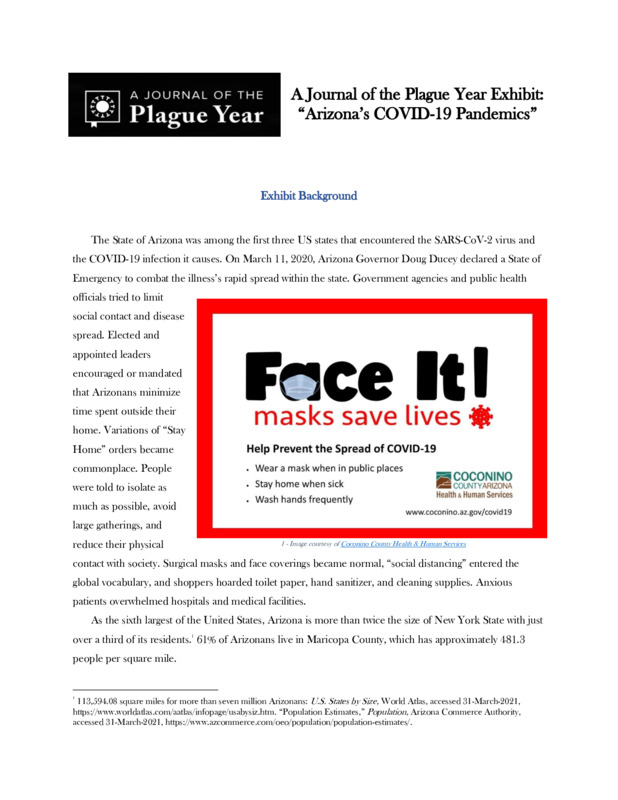
2021-04-20
While working as a curatorial intern on ASU's 'A Journal of the Plague Year' COVID-19 archive, I created this exhibit on the pandemic experience within the state.
In addition to obvious, overarching realities such as socioeconomic status and immediate access to healthcare systems, I initially believed one of the greatest deciding factors that determined one's experience in Arizona was an individual's residence in either predominantly urban or rural environments. The proposed exhibit had been originally titled "A Tale of Two Arizonas" to pay respect to Charles Dickens and the differing realities experienced here.
To test my proposed hypothesis, I went about finding data, stories, and submissions that substantiated or disputed my premise. Within a short time, I had identified four distinct environmental drivers of personal pandemic experiences; to me, that indicated the existence of many more I hadn't yet found or had overlooked along the way. My evidence suggested a minimum of four pandemic locales: Urban, Rural, Border, and Tribal within the State of Arizona and its fifteen counties. The recorded health data and personal experiences demonstrated the naivete of my initial hypothesis, and I retitled the exhibit: "Arizona's COVID-19 Pandemics."
The Exhibit Background section illustrates the vast dichotomies within Arizona in terms of population density and access to healthcare facilities. Given the virus's respiratory nature, these factors seemed especially relevant to driving diverse local experiences. I chose to include a flyer from the Coconino County Health and Human Services' "Face It! Masks Save Lives" campaign. The flyer included a specific line to "Stay Home When Sick" that seemed to illustrate a different public health paradigm than the broader "stay home" orders from Maricopa and Pima county. This section also features an image of Sedona's red rocks and a portion of The Wave to remind visitors of the wide-open rural areas accessible to all, as well as those with cultural significance to the Native American tribes and limited access to the general public.
The next section asks a short, five-question survey in which visitors may participate.
The Silver Linings piece features a short audio clip of a father and husband discussing some unexpected benefits of the pandemic. Visitors may explore additional Silver Linings stories and submit their own experience.
The Tséhootsooí Medical Center piece seeks to illustrate the different pandemic experience on the state's tribal lands. I hoped to inspire some relevant emotional turmoil for the visitors through the piece's visual presentation. I wanted to create a series of waves with quotes from the medical center's healthcare workers. I hoped visitors' attention would be drawn to the large, bolded key words, and that they would first experience the segments out of sequence because of that. After potentially feeling a sense of chaos, they might settle themselves into a deliberate reading of the texts and find their own order within the experiences provided here. This piece allows further exploration of Native submissions and topics, a review of an additional related news article, and a submission prompt that invites visitors to offer guidance to hospital managers.
The next piece illustrates the differences between mask mandates in communities across Arizona. In addition to hearing an audio clip of interviews with mayors and a public health official, visitors can explore additional submissions related to mask mandates and submit their thoughts on statewide mandates.
The Arizona Department of Health Services provides zip-code specific infection data on its website, and the wide array of known case infections therein further illustrates potential dichotomies across the state. In working to include and represent this data in a consumable way, I encountered inconsistencies with tribal data. The nation's Indian tribes are overseen by Indian Health Services, a federal public health agency, and it does not collect or report data in the same manner as the State of Arizona or its counties. At first glance, the data would seem to suggest that tribal areas had less severe pandemic experiences than the rural and urban areas, which was not objectively true. I wanted to offer the unedited data to visitors, allow them to drawn their own conclusions, and invite them to offer their thoughts on what potential misunderstandings might emanate from these reporting differences. Visitors may also choose to review the foundational data from this piece, as well.
I used the following two sections to offer submission prompts about the visitor's overall pandemic experience as a function of their location, as well as what they might have done if placed in charge of their city, county, or state during this pandemic.
A diverse Search section allows visitors to explore additional topics of interest to them. 23 hyperlinks offer pre-defined search parameters. An Advanced Search link allows self-defined research, and a Join The Staff link connects visitors with opportunities to work within the JOTPY archive.
A final section asks visitors to provide feedback on the exhibit, its content, and the pandemic in general.
Both surveys within the exhibit will display overall results to visitors who participate in them.
Through this process, I found incredible amounts and diversity of data outside the archive that spoke to these generally localized experiences, but not that much yet within the archive explained what Arizonans had experienced outside the state's urban environments. I created a call for submissions and delivered it to fifty rural entities that might help support the effort to collect and preserve more rural Arizona stories. Between all the local libraries, historical societies, museums, small-town mayors, and county health officials to whom I asked for help, I am optimistic the archive will better represent all Arizonans in the coming months and years. Despite the exhibit having been created, I ensured its internal search features would include future submissions and allow the exhibit to remain relevant long after its release.
-

2021-04-20
During March and April 2021, I created an online exhibit from content within Arizona State University's "A Journal of the Plague Year" COVID-19 archive. Entitled "Arizona's COVID-19 Pandemics," the digital exhibit contained images previously submitted to the archive, along with several copyright-free images I found on pexels.com. I have attached all these images. Listed by their order of appearance within the exhibit, their sources are as follows:
1- "Face It" Campaign flyer: Coconino County Health & Human Services ( https://covid-19archive.org/s/archive/item/42998 )
2- Red Rocks, Sedona: Courtesy of Gregory Whitcoe via Pexels.com
3- Online Learning: Courtesy of August de Richelieu via Pexels.com
4- Tséhootsooí Medical Center staff: Courtesy of FDIHB Marketing Department and Navajo Times newspaper ( https://covid-19archive.org/s/archive/item/41189 )
5- Arizona's Mask Mandate Map: created by Sarandon Raboin ( https://covid-19archive.org/s/archive/item/26267 )
6- Arizona COVID-19 Infection Zip Code Map: Courtesy of Arizona Department of Health Services ( https://covid-19archive.org/s/archive/item/42035 )
7- Woman Shopping: Courtesy of Anna Shvets via Pexels.com
8- Woman on Rural Arizona Road: Courtesy of Taryn Elliot via Pexels.com
9- Masked Woman in Crowd: Courtesy of Redrecords via Pexels.com
10- The Wave: Courtesy of Flickr via Pexels.com (this image is found only in the PDF submission of the exhibit, not in the public-facing exhibit itself due to document formatting technicalities - the PDF version can be found at https://covid-19archive.org/s/archive/item/42998 )
-
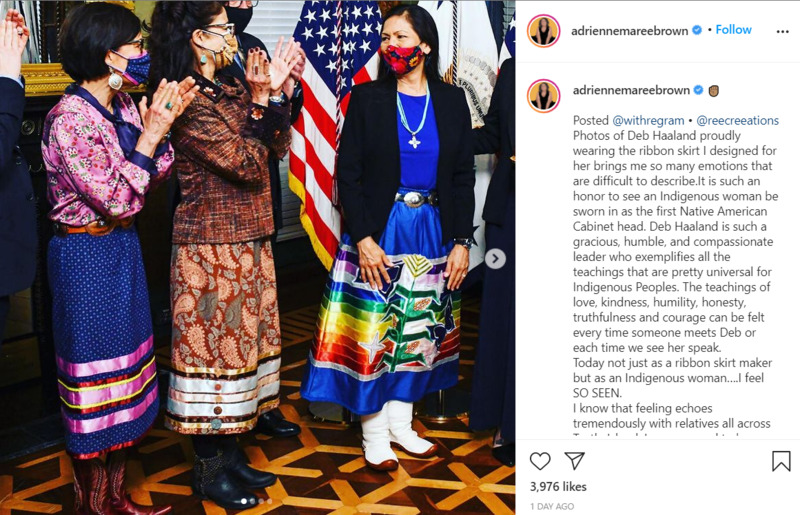
2021-03-20
Photos of Deb Haaland proudly wearing the ribbon skirt I designed for her brings me so many emotions that are difficult to describe.It is such an honor to see an Indigenous woman be sworn in as the first Native American Cabinet head. Deb Haaland is such a gracious, humble, and compassionate leader who exemplifies all the teachings that are pretty universal for Indigenous Peoples. The teachings of love, kindness, humility, honesty, truthfulness and courage can be felt every time someone meets Deb or each time we see her speak.
Today not just as a ribbon skirt maker but as an Indigenous woman….I feel SO SEEN.
I know that feeling echoes tremendously with relatives all across Turtle Island. I am so proud to have been a part of this historic moment in some way. Thank you and shoutout to my friends Margaret Gonzalez and Shane Balkowitsch for asking me to make her a ribbonskirt.
✨✨✨✨✨✨
The ribbon skirt reminds us of the matriarchal power we carry as Indigenous women.
They carry stories of survival, resilience, adaption, and sacredness.
As survivors of genocide we wear our ribbon skirts to stay grounded in our teachings, to stay connected to the earth and our ancestors.
✊🏽✊🏽✊🏽✊🏽✊🏽
Wearing it in this day and age is an act of self empowerment and reclamation of who we are and that gives us the opportunity to proudly make bold statements in front of others who sometimes refuse to see us.
It allows us to be our authentic selves unapologetically.
This is extremely important to me because when I was a little girl, the hate and racism I experienced as a First Nations person left me feeling shame.
As the daughter of a Residential school survivor and a Sixties scoop survivor, sewing ribbon skirts has brought so much healing to my life. Expressing myself in a cultural and creative way that allows me to feel the strength of my ancestors has given me the space I needed to shed that shame I carried.
Sewing is my love language.
Extremely honored ~ Agnes Woodward @agneswoodward
#ribbonskirts #ribbonskirt #IndigenouswomenEmpowered #DebHaaland #MatriarchalPower
-
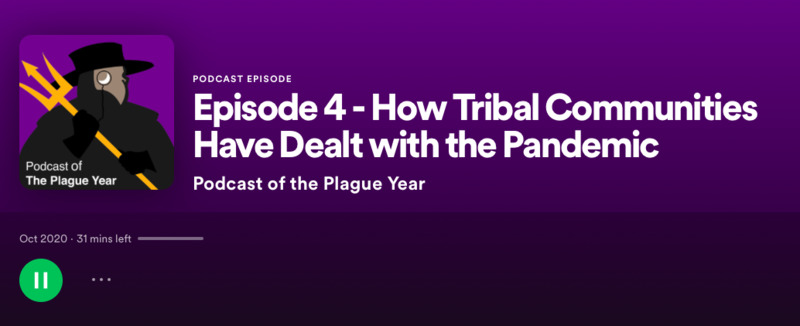
2020-10
A cursory look into A Journal of the Plague Year reveals that the pandemic is nondiscriminatory, all of are affected. Yet, the reality is that Covid-19 is having more impact on certain populations in American communities. Arizona State University's Center for the Study of Religion and Conflict partnered with the Henry Luce Foundation to provide rapid relief funding to marginalized communities in the southwest. As part of the rapid relief program, the Center for the Study of Religion and Conflict is collaborating with A Journal of the Plague Year and the Walter Cronkite School of Journalism and Mass Communication to raise awareness about the marginalized communities that were assisted via this grant.
By joining this "Southwest Stories" project, we at the Podcast of the Plague Year were granted the opportunity to spotlight one Native American community in Arizona- the White Mountain Apache Tribe.
-
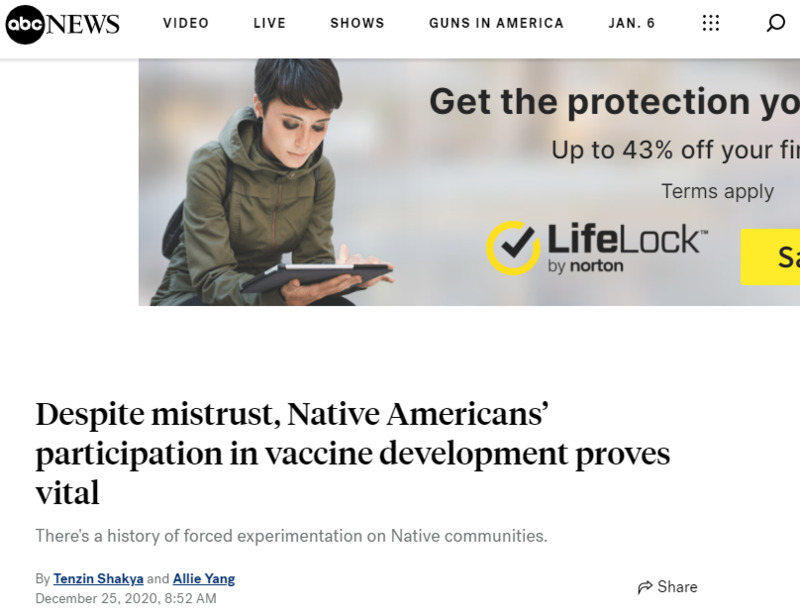
2021-01-24
The story details how the Navajo Nation is fighting back against COVID-19. In particular, an indigenous healer, Timothy Lewis, volunteers in a Pfizer COVID-19 vaccine trial.
-
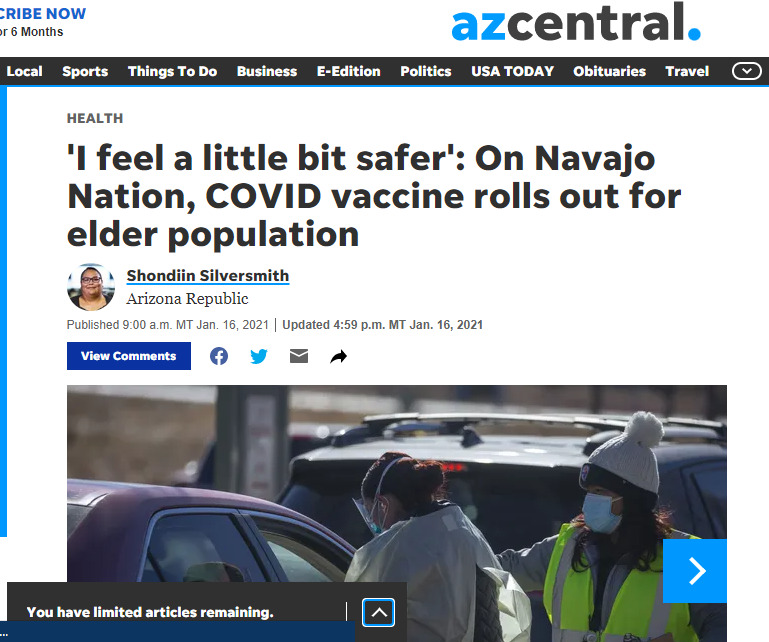
2021-01-24
Tséhootsooí Medical Center hosts drive-thru COVID-19 vaccine event. Elderly residents, 75 and older, of the Navajo Nation (Fort Defiance), are given the COVID-19 vaccine at Tséhootsooí Medical Center
-
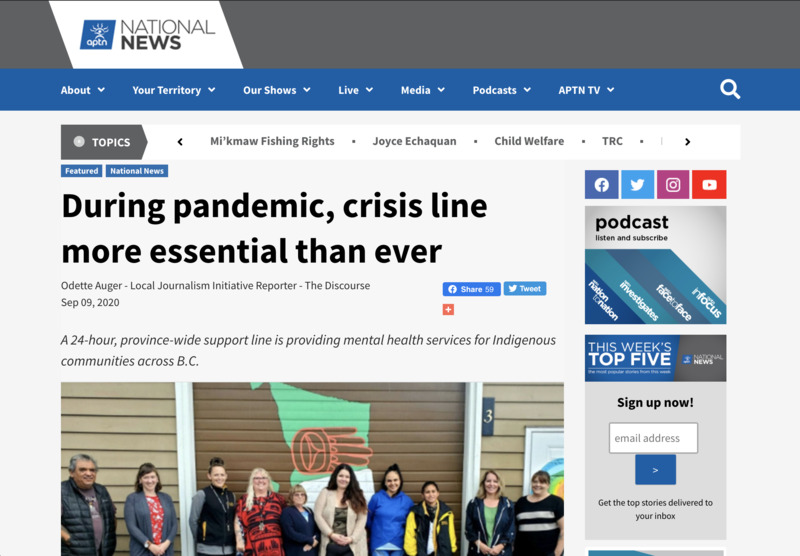
2020-09-09
An article from the Aboriginal Peoples Television Network (APTN) about the importance of crisis phone lines to mental health in Indigenous communities
-
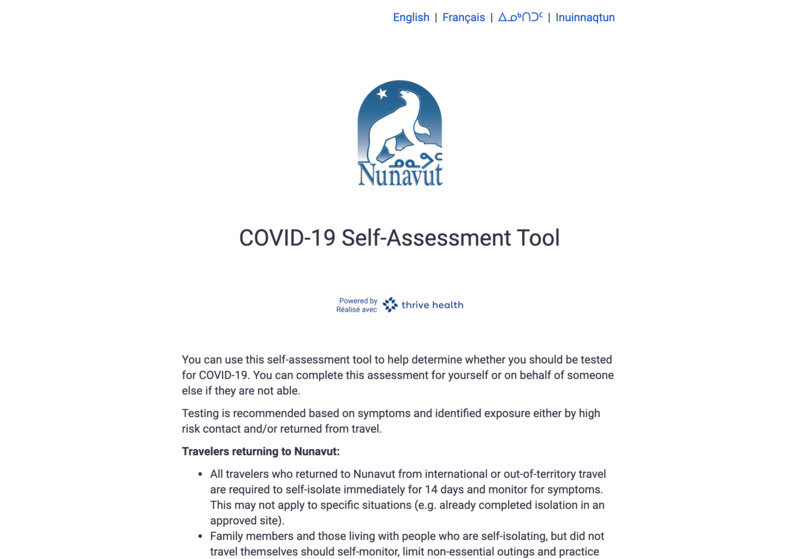
2020
An online self-assessment tool to determine if one should be tested for COVID-19
-
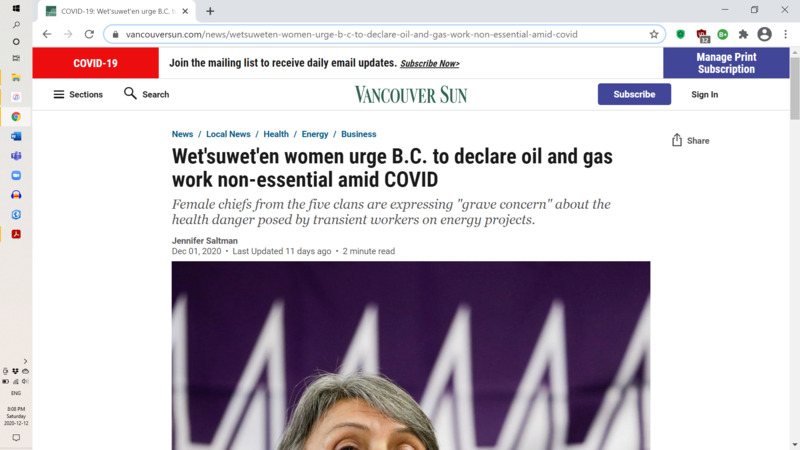
2020-12-01
Article discussing the Wet'suwet'en women petitioning for the oil and gas industry to not be considered "essential"
-
2020-05-10
his article posted by Indian Country Today about Indigenous artists that are infusing their work with important health, safety messages as the pandemic hits some tribal communities particularly hard. The pandemic has hit the Native American community particularly hard, yet we hear very little about it in the media. Native American artists are taking it upon themselves to send messages of hope and safety.
-
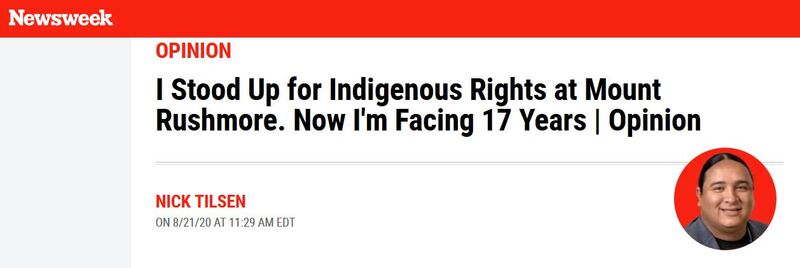
2020-08-21
On July 4th 2020, United States President Donald Trump held a controversial political rally at Mount Rushmore, South Dakota. The rally was controversial for a number of reasons, the first being that during the height of the covid-19 pandemic – social distancing and mask-wearing policies were not enforced during the rally. The political rally was also held on sacred Indigenous land and what was once part of the Lakota Sioux territory. To many Indigenous and non-Indigenous people alike, this action felt like a slap in the face to Indigenous communicates who are facing disproportionate affects from the covid-19 pandemic. This opinion piece is written by Oglala Lakota citizen, and president and CEO of the NDN Collective, Nick Tilsen who is facing felony charges and up-to-17 years in prison for exercising his first amendment right to protest on the day of the rally.
-
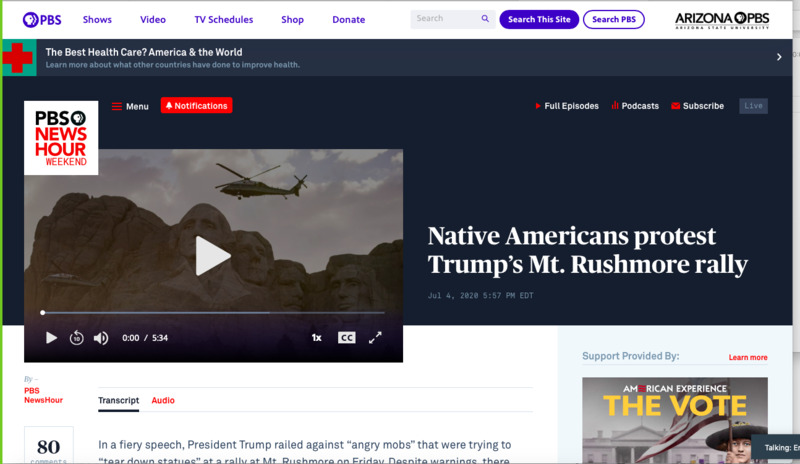
2020-07-04
The pandemic has amplified existing societal and systemic injustices and racism in the United States. In 2020, fighting for social justice has been just as important as looking for a covid-19 vaccine. President Trump has inflamed flashpoints among his base, mostly white conservative voters, and Black and Indigenous People of Color. As an example, Trump held a 4th of July rally on sacred Sioux land at Mt. Rushmore, which seemed like an intentional act to show that Indigenous peoples hold no power or sovereignty there. This interview was conduced by PBS with Chase Iron Eyes, who is Special Advisor to the president of the Ogala Sioux Tribe.
-

2020-08-05
By McKenzie Allen-Charmley/Luce Foundation: Southwest Stories Fellowship
-
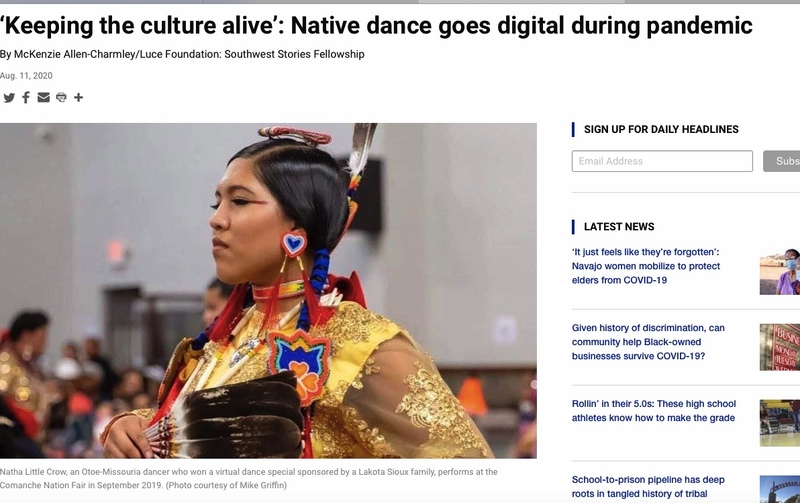
2020-08-11
By McKenzie Allen-Charmley|Luce Foundation: Southwest Stories Fellowship
-
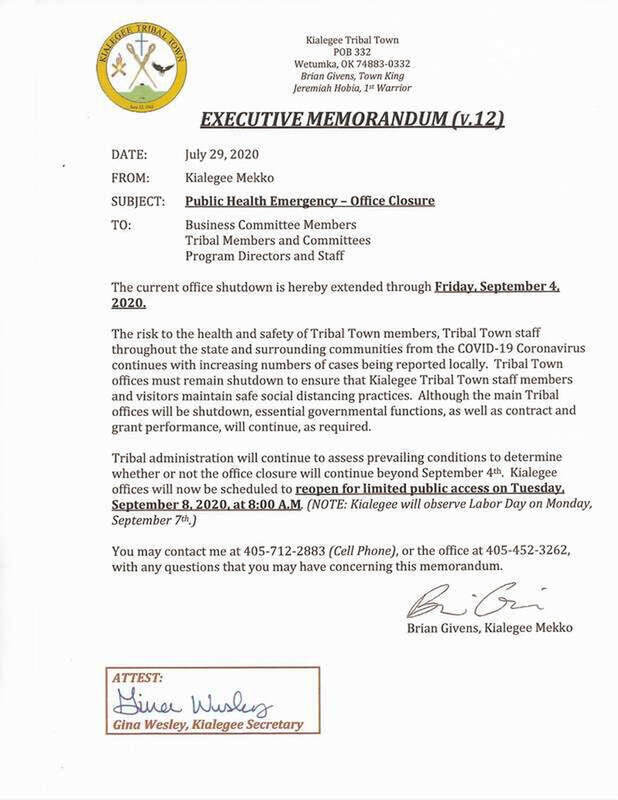
2020-07-29
"The risk to the health and safety of Tribal Town members, Tribal Town staff throughout the state and surrounding communities from the COVID-19 Coronavirus continues with increasing numbers of cases being reported locally. Tribal Town offices must remain shutdown to ensure that Kialegee Tribal Town staff members and visitors maintain safe social distancing practices."
-
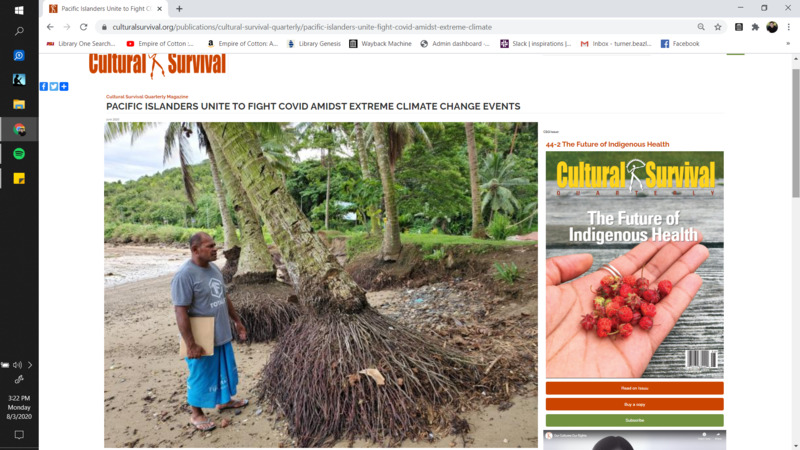
2020-06-01
"COVID-19, measles, and dengue fever are not the only risks the Pacific islands face. These island nations collectively emit less than one percent of the world’s greenhouse gas emissions, yet they disproportionately experience the impacts of the climate crisis. There are 20 sovereign island nations in the Pacific, with between 20,000-30,000 islands covering more than 16 million square miles of the Pacific Ocean. The region possesses one of the world’s richest biodiversities and unique cultures, with more than 1,500 Indigenous spoken languages. Papua New Guinea alone is home to well over 800 Indigenous languages, more than most other countries in the world. The remoteness of this constellation of islands within the southern hemisphere puts the region at a distinct advantage over COVID-19. However, relatively small land masses with growing populations heighten the region’s susceptibility to the multiplicative effects of the measles and dengue fever epidemics, the COVID-19 pandemic, and the brutal impacts of climate change."
-
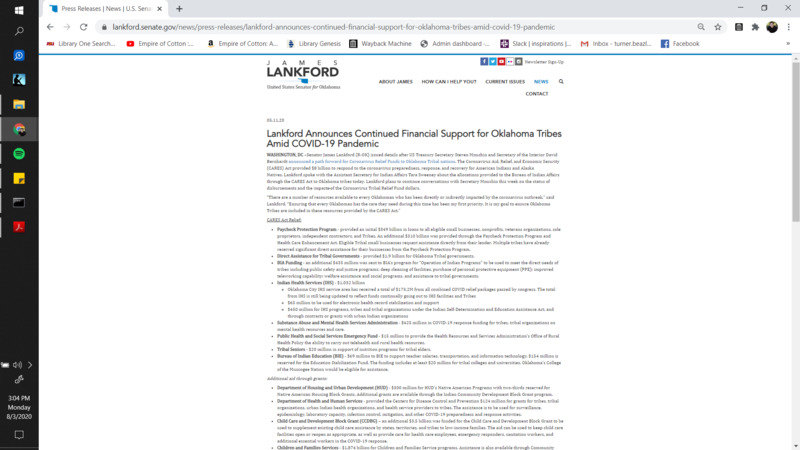
2020-05-11
"Senator James Lankford (R-OK) issued details after US Treasury Secretary Steven Mnuchin and Secretary of the Interior David Bernhardt announced a path forward for Coronavirus Relief Funds to Oklahoma Tribal nations. The Coronavirus Aid, Relief, and Economic Security (CARES) Act provided $8 billion to respond to the coronavirus preparedness, response, and recovery for American Indians and Alaska Natives. Lankford spoke with the Assistant Secretary for Indian Affairs Tara Sweeney about the allocations provided to the Bureau of Indian Affairs through the CARES Act to Oklahoma tribes today. Lankford plans to continue conversations with Secretary Mnuchin this week on the status of disbursements and the impacts of the Coronavirus Tribal Relief Fund dollars."
-
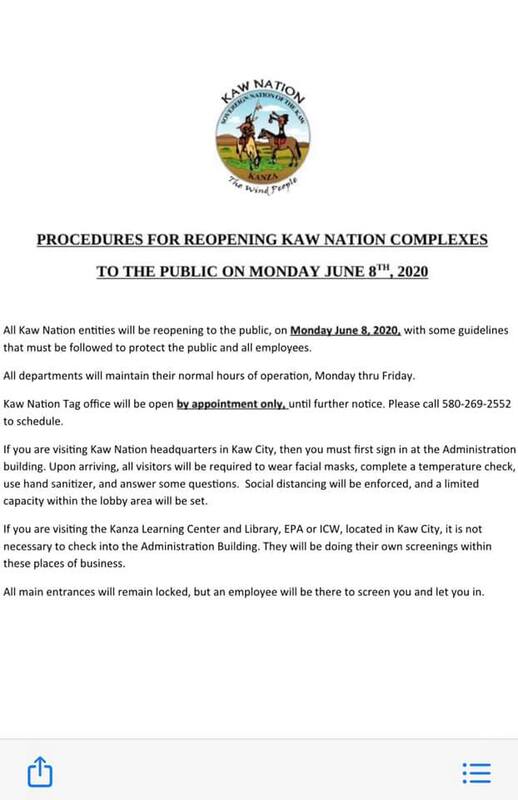
2020-06-05
"All Kaw Nation entities will be reopening to the public, on Monday June 8, 2020, with some guidelines that must be followed to protect the public and all employees."
-
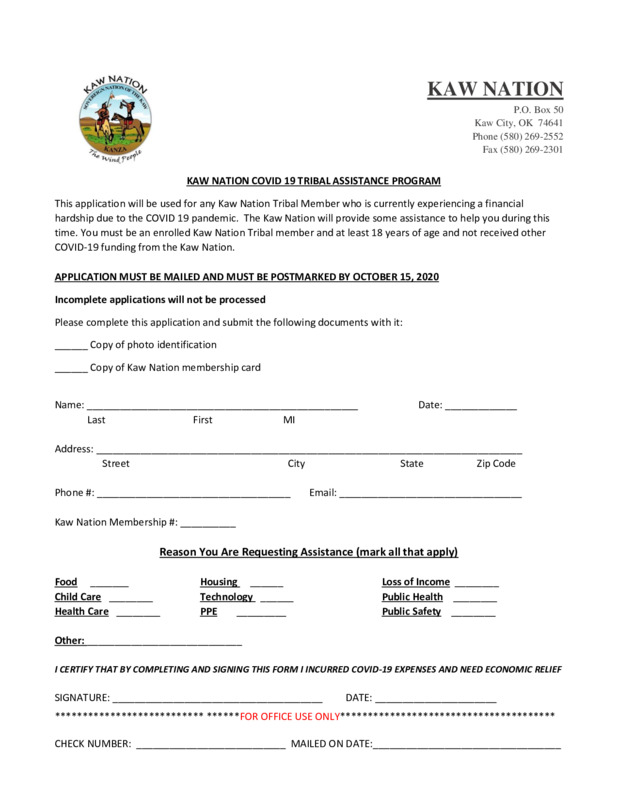
2020-06-01
"This application will be used for any Kaw Nation Tribal Member who is currently experiencing a financial hardship due to the COVID 19 pandemic. The Kaw Nation will provide some assistance to help you during this time. You must be an enrolled Kaw Nation Tribal member and at least 18 years of age and not received other COVID-19 funding from the Kaw Nation."
-
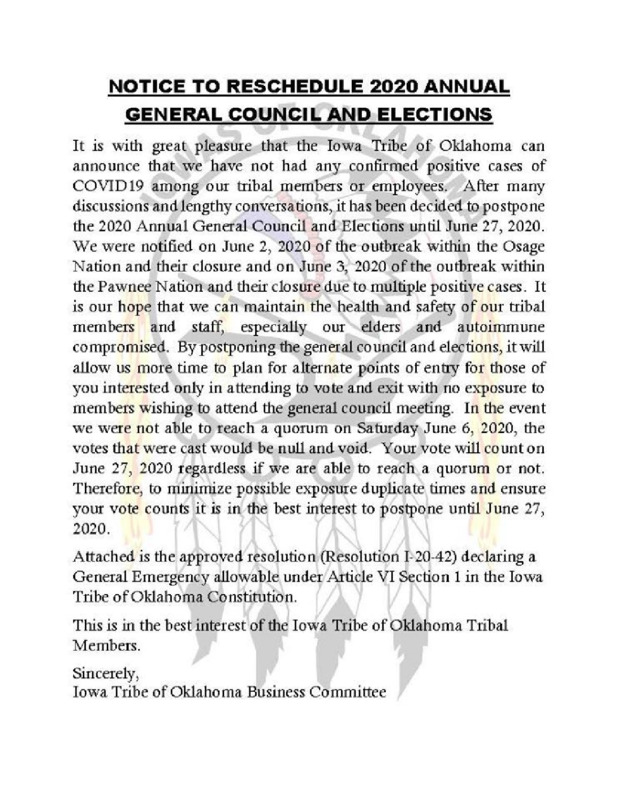
2020-06-03
"It is with great pleasure that the Iowa Tribe of Oklahoma can announce that we have not had any confirmed positive cases of COVID10 among our tribal members or employees. After many discussions and lengthy conversations, it has been decided to postpone the 2020 Annual General Council and Elections until June 27, 2020... Attached is the approved resolution (Resolution I-20-42) declaring a General Emergency allowable under Article VI Section 1 in the Iowa Tribe of Oklahoma Constitution."
-
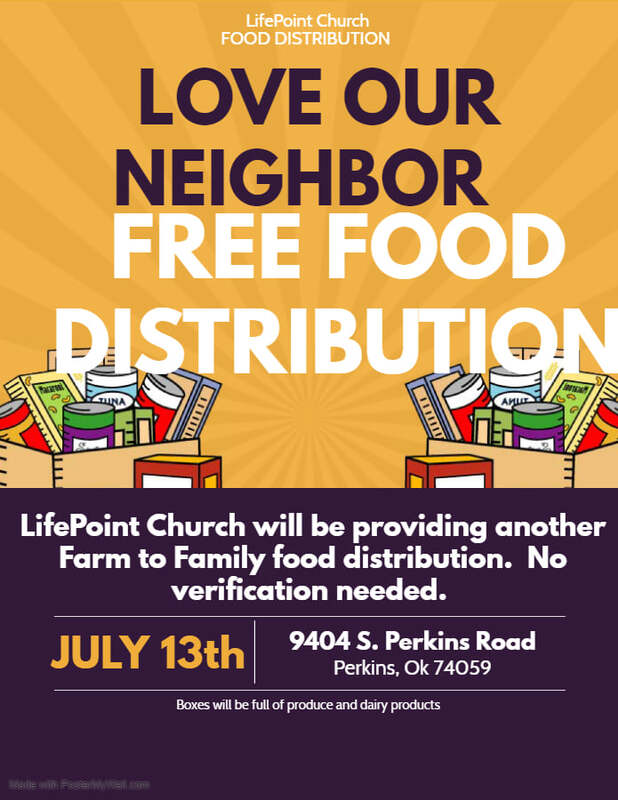
2020-07-13
"LifePoint Church will be providing another Farm to Family food distribution. No verification needed."
-

2020-07-02
"Title VI of the Social Security Act, as amended by Title V of Division A of the Coronavirus Aid, Relief, and Economic Security Act (Public Law 115-136), provides that the Department of the Treasury (Treasury) Office of Inspector General (OIG) is responsible for monitoring and oversight of the receipt, disbursement, and use of Coronavirus Relief Fund payments. Treasury OIG also has authority to recover funds in the event that it is determined a recipient of a Coronavirus Relief Fund payment failed to comply with requirements of subsection 601(d) of the Social Security Act, as amended, (42 U.S.C. 801(d))."
-
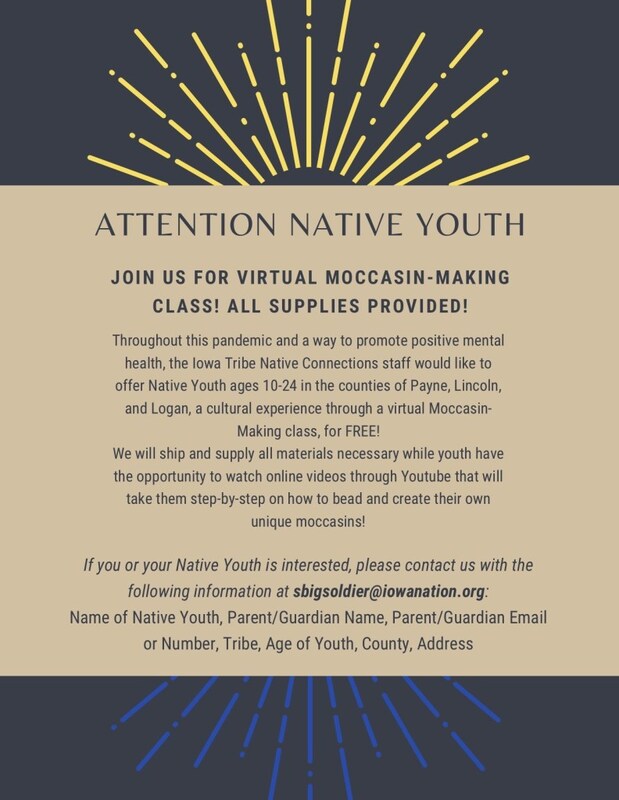
2020-05-28
"Throughout this pandemic and a way to promote positive mental health, the Iowa Tribe Native Connections staff would like to offer Native Youth ages 10-24 in the counties of Payne, Lincoln, and Logan, a cultural experience through a virtual Moccasin-Making class, for FREE!"
-
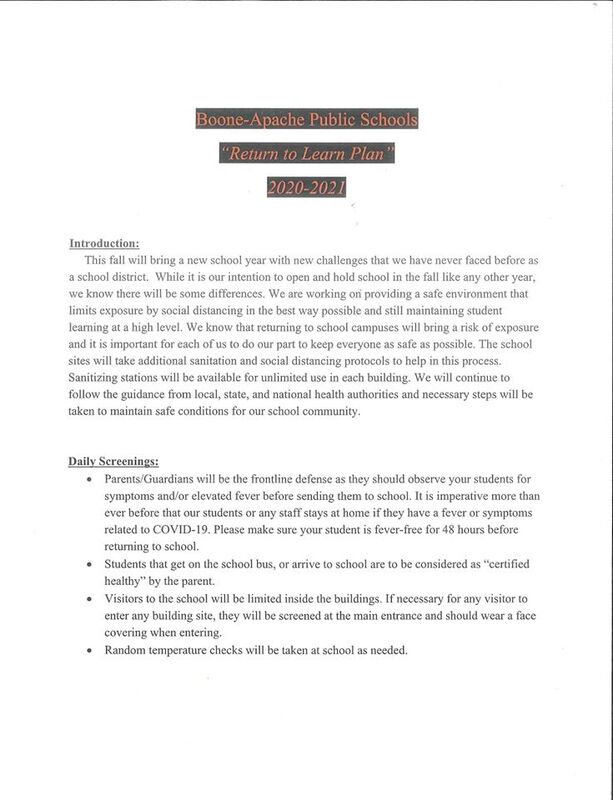
2020-07-30
"This fall will bring a new school year with new challenges that we have never faced before as a school district. While it is our intention to open and hold school in the fall like any other year, we know there will be some differences. We are working on providing a safe environment that limits exposure by social distancing in the best way possible and still maintaining student learning at a high level. We know that returning to school campuses will bring a risk of exposure and it is important for each of us to do our part to keep everyone as safe as possible."
-
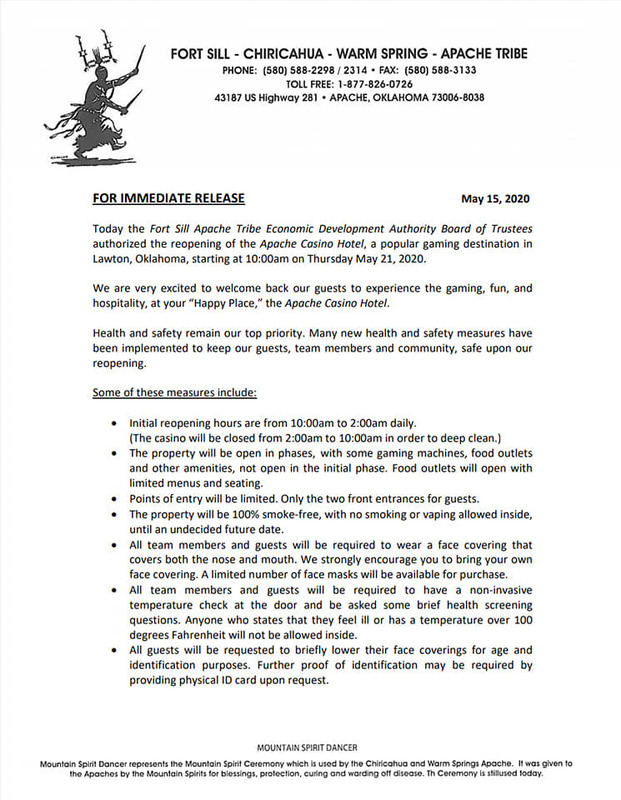
2020-05-15
"Today the Fort Still Apache Tribe Economic Development Authority Board of Trustees authorized the reopening of the Apache Casino Hotel, a popular gaming destination in Lawton, Oklahoma, starting at 10:00am on Thursday May 21, 2020."
-

2020-07-06
"We are living in an unprecedented time, facing unprecedented challenges. Situations, details change daily, sometimes even hourly. I think it’s important that you know that our tribe is stable. We have always been a tribe known for paying its bills, taking care of our people, limiting our debt. Let me assure you that is still the Easter Shawnee Tribe, even in these turbulent times. Let me also assure you, your Business Committee, your Business Managers, your tribal employees and your Chief are working tirelessly to address these current challenges. Let me further assure you that with every decision we make, we are acutely concerned with how that decision impacts our tribal citizens. You, each one of you, you are our number one concern."
-
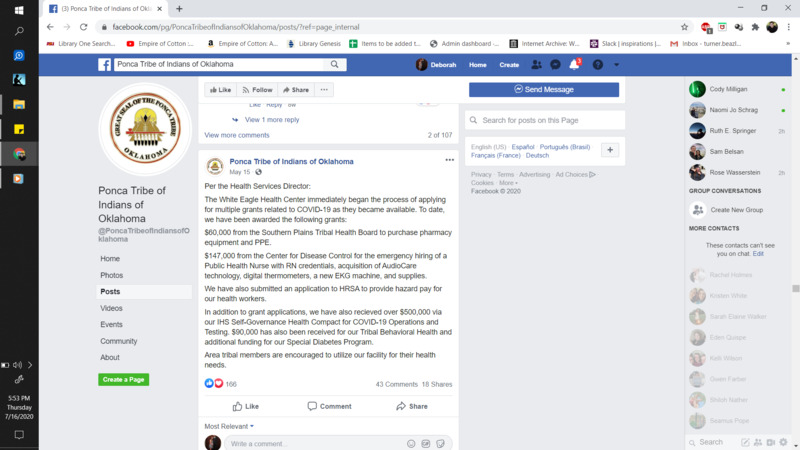
2020-05-15
"Per the Health Services Director: The White Eagle Health Center immediately began the process of applying for multiple grants related to COVID-19 as they became available. To date, we have been awarded the following grants:"
-

2020-03-24
"Based on the Ponca Resolution 19-03192020 for Declaring a State of Emergency Related to COVID-19 passed by the Ponca Tribal Business Committee on March 19th, 2020, All buildings will be closed until April 6th except Finance, Social Development Center, and The White Eagle Health Center. Most programs have already been working from home at this time. The safety of our employees and tribal members are taken seriously and admin leave is granted for all employees on leave."
-
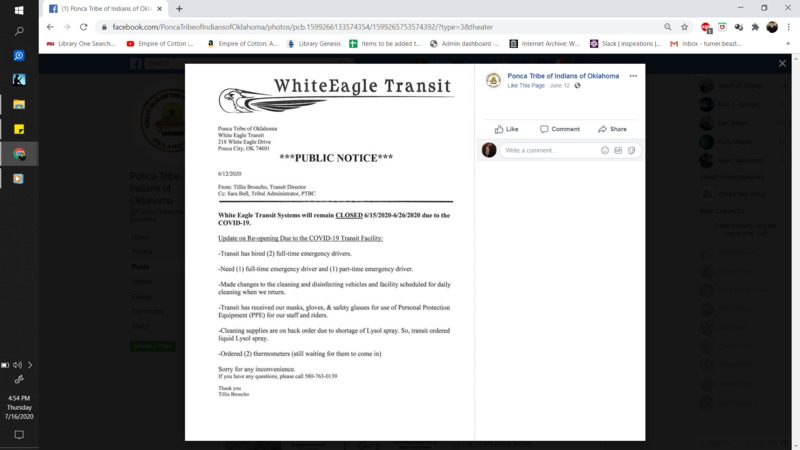
2020-06-12
"White Eagle Transit Systems will remain CLOSED 6/15/2020-6/26/2020 due to the COVID-19."
-

2020-06-15
"The health, safety, and education of our students is the top priority for Ponca City Public Schools. Due to the current issues with COVID-19, we are requesting the input from our parents and students regarding the three different learning options."
-
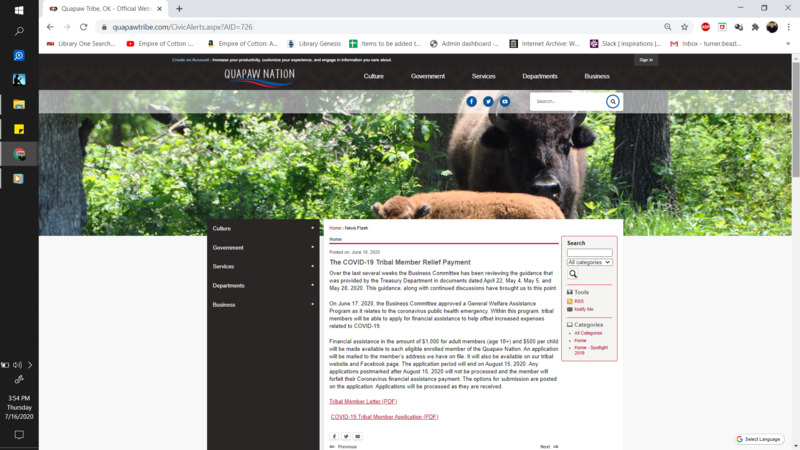
2020-06-18
"Financial assistance in the amount of $1,000 for adult members (age 18+) and $500 per child will be made available to each eligible enrolled member of the Quapaw Nation. An application will be mailed to the member’s address we have on file. It will also be available on our tribal website and Facebook page. The application period will end on August 15, 2020. Any applications postmarked after August 15, 2020 will not be processed and the member will forfeit their Coronavirus financial assistance payment. The options for submission are posted on the application. Applications will be processed as they are received."
-
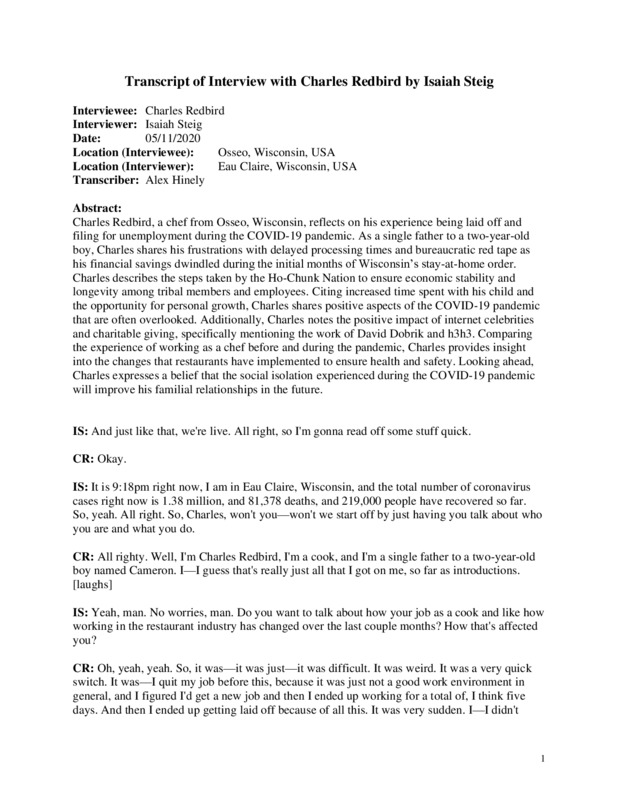
05/11/2020
Charles Redbird, a chef from Osseo, Wisconsin, reflects on his experience being laid off and filing for unemployment during the COVID-19 pandemic. As a single father to a two-year-old boy, Charles shares his frustrations with delayed processing times and bureaucratic red tape as his financial savings dwindled during the initial months of Wisconsin’s stay-at-home order. Charles describes the steps taken by the Ho-Chunk Nation to ensure economic stability and longevity among tribal members and employees. Citing increased time spent with his child and the opportunity for personal growth, Charles shares positive aspects of the COVID-19 pandemic that are often overlooked. Additionally, Charles notes the positive impact of internet celebrities and charitable giving, specifically mentioning the work of David Dobrik and h3h3. Comparing the experience of working as a chef before and during the pandemic, Charles provides insight into the changes that restaurants have implemented to ensure health and safety. Looking ahead, Charles expresses a belief that the social isolation experienced during the COVID-19 pandemic will improve his familial relationships in the future.
-
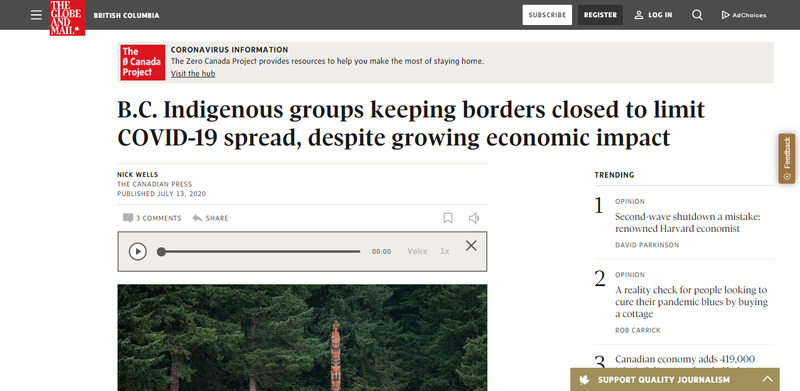
2020-07-13
"Indigenous bands along the west coast of British Columbia say their borders will remain closed to tourists and non-residents, despite the economic impact, as they work to raise awareness about the threat COVID-19 poses to their communities."
"'A lot of our communities are remote and testing is not easily available,' she said. 'If you’re in Port Alberni, or Nanaimo, or Victoria, or somewhere (else), you can get testing and get results in 24 hours. It’s not the same with our communities.'
"The closures have resulted in disputes between Indigenous groups and local businesses.
"The Haida Nation in Haida Gwaii have turned away non-residents at the ferry terminal, discouraged leisure travel and called on two local fishing lodges to rethink their reopening plans."
-
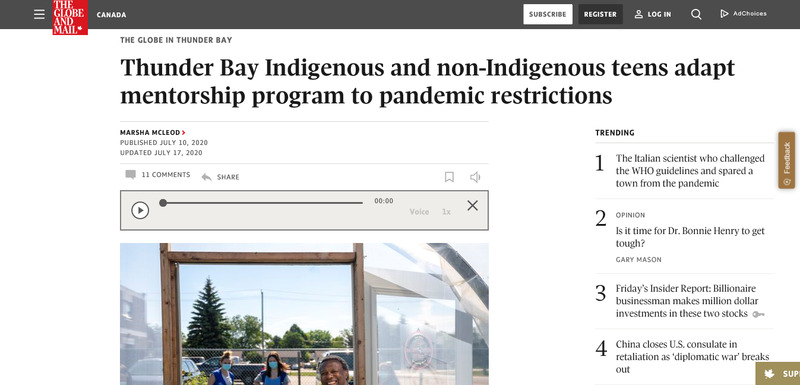
2020-07-10
An in-depth article looking at the way Regional Multicultural Youth Council of Northern Ontario and its director Moffat Makuto are attempting to adapt and continue to support the community during the pandemic when they were already struggling financially prior to this event.
"The pandemic presented a new challenge to the 70-year-old restaurant owner and executive director of the Multicultural Association of Northwestern Ontario, which is the council’s parent organization.
"'Continuity when you work with young people is very important,' Mr. Makuto said.
"Before the pandemic, the council met weekly, often at the centre, to plan their many initiatives. For instance, the council held a monthly discussion with high-schoolers from across the city on relevant issues. One session before the shutdown focused on how to create safer schools for LGBTQ2S students.
"Council meetings have since moved online, but Mr. Makuto said it’s been difficult to organize, as some young people lack enough data on their phones to participate or were relying on local libraries for internet access.
"The council would also normally run after-school programming – and provide food – on weekdays at Dennis Franklin Cromarty High School, which serves First Nations students, including those who come to Thunder Bay for school from home communities in Northern Ontario."
-
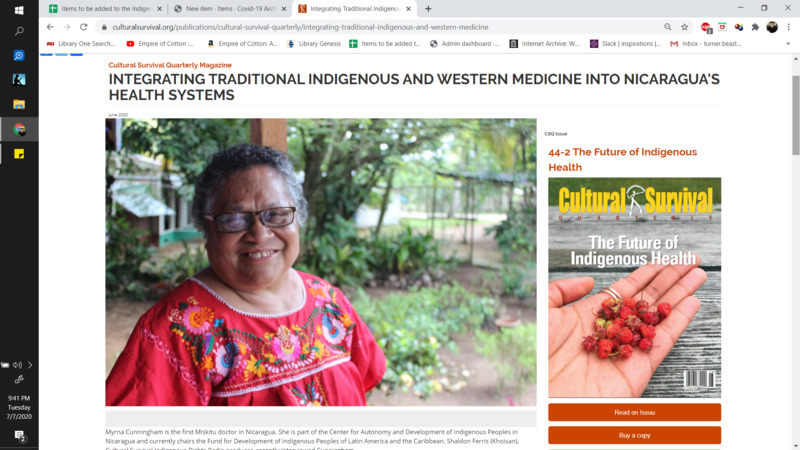
2020-06
"In Nicaragua and specifically in our autonomous region, we have organized a family and communal-based model of a health system."
-
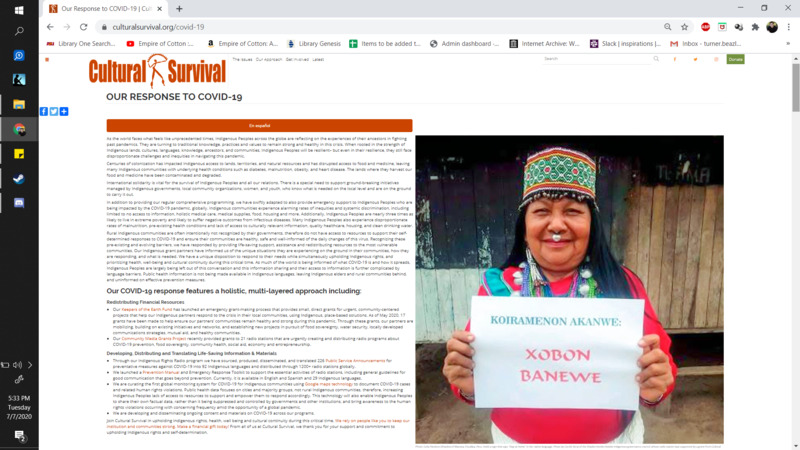
2020
"International solidarity is vital for the survival of Indigenous Peoples and all our relations. There is a special need to support ground-breaking initiatives managed by Indigenous governments, local community organizations, women, and youth, who know what is needed on the local level and are on the ground to carry it out."
-
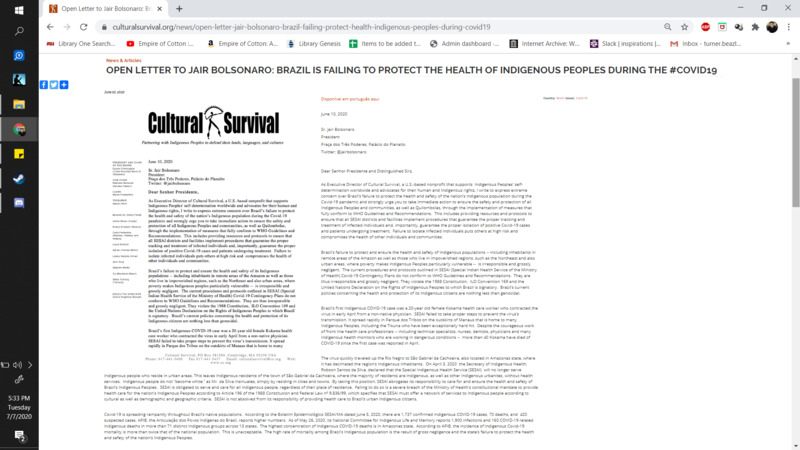
2020-06-10
"Brazil’s current policies concerning the health and protection of its Indigenous citizens are nothing less than genocidal."
-
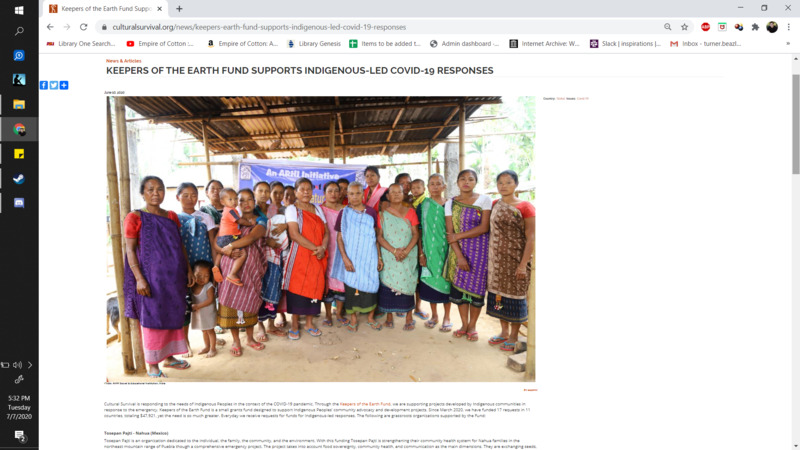
2020-06-10
"Cultural Survival is responding to the needs of Indigenous Peoples in the context of the COVID-19 pandemic."
-

2019-06-04
"We have a great diversity of Indigenous Peoples in the world, Peoples who have been affected in different ways by the COVID-19 pandemic. To name us is to recognize our existence, which is the result of hundreds of years of resistance against invasions and previous epidemics similar to COVID-19. "
-
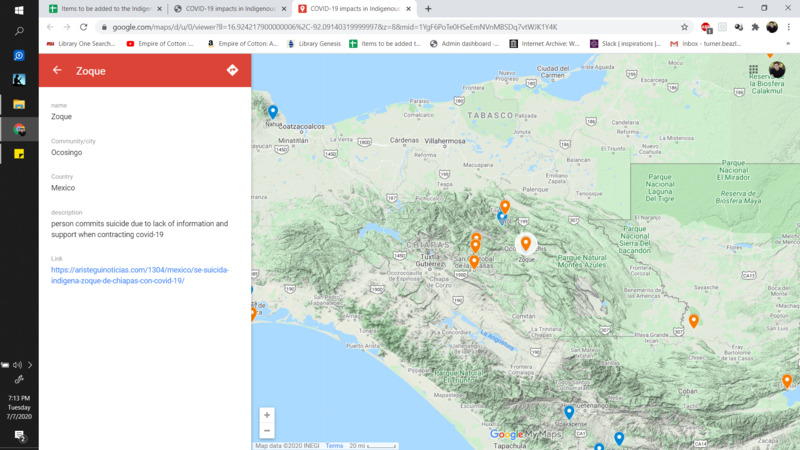
2020
"Due to the need to present information disaggregated by Indigenous Peoples (IP), Cultural Survival is producing this map to collect and disseminate information to show the IP situation. Due to the constant increase of cases and the lack of testing in rural areas, the data presented here will vary over time. It is a continuous and not exhaustive effort and we invite you to contribute with us"
-
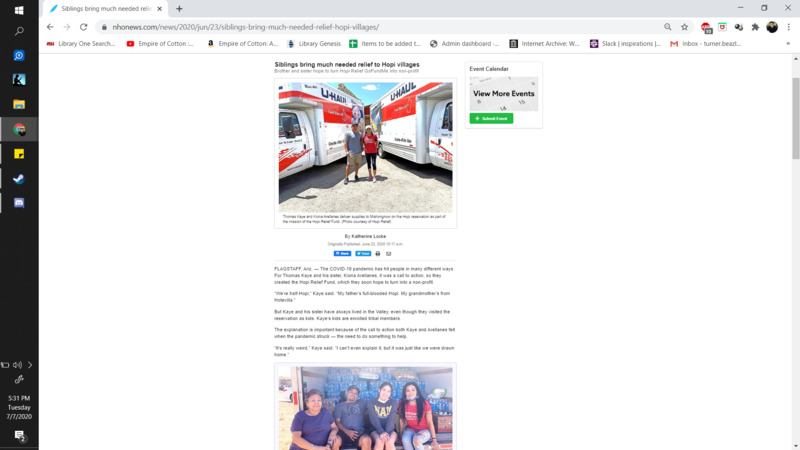
2020-06-23
"Thomas Kaye and Kiona Arellanes deliver supplies to Mishongnovi on the Hopi reservation as part of the mission of the Hopi Relief Fund. "
-
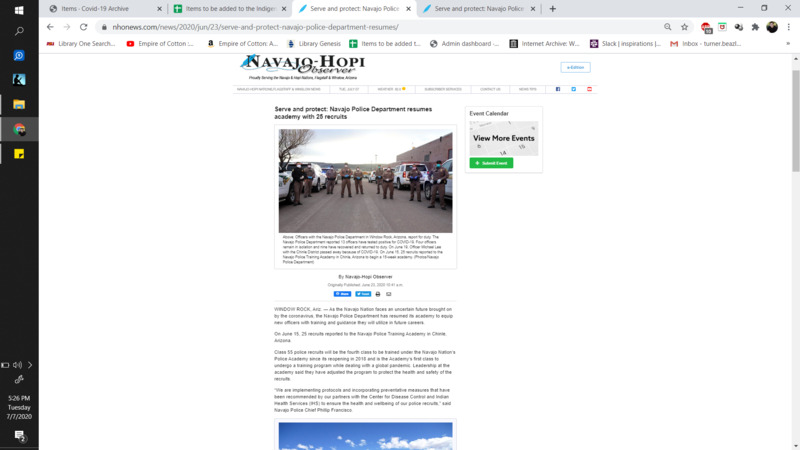
2020-06-23
"Officers with the Navajo Police Department in Window Rock, Arizona, report for duty. The Navajo Police Department reported 13 officers have tested positive for COVID-19. Four officers remain in isolation and nine have recovered and returned to duty. On June 19, Officer Michael Lee with the Chinle District passed away because of COVID-19. On June 15, 25 recruits reported to the Navajo Police Training Academy in Chinle, Arizona to begin a 15-week academy. (Photos/Navajo Police Department)"
-

2020-06-09
"Diné College science professors release research paper on Native Americans susceptibility to the virus."
-
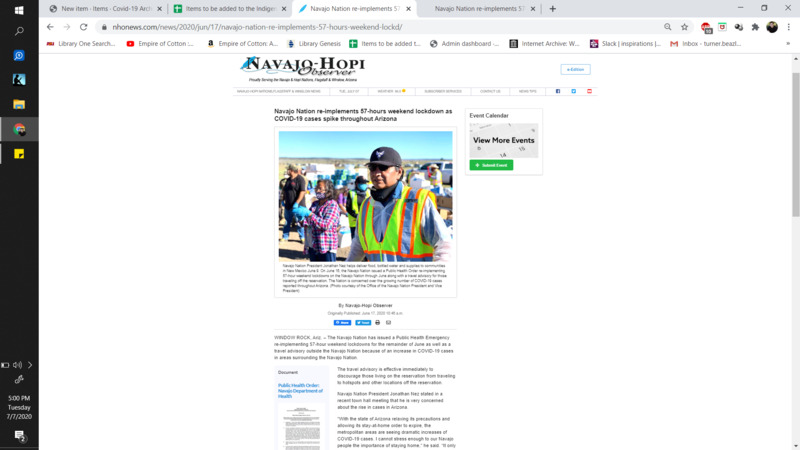
2020-06-17
"The Navajo Nation has issued a Public Health Emergency re-implementing 57-hour weekend lockdowns for the remainder of June as well as a travel advisory outside the Navajo Nation because of an increase in COVID-19 cases in areas surrounding the Navajo Nation."
-
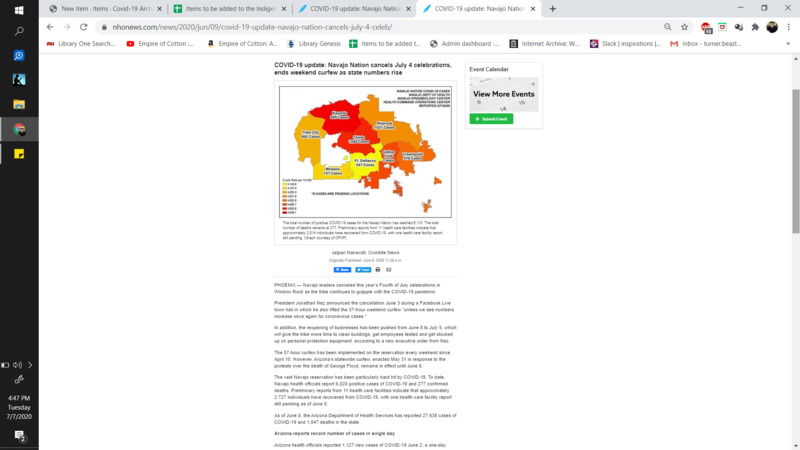
2020-06-28
"Navajo leaders canceled this year’s Fourth of July celebrations in Window Rock as the tribe continues to grapple with the COVID-19 pandemic."
-

2020-06-27
"The farmer Augusta Starostina from Eveno-Bytantaysky national Evenki district of Yakutia took up the production of cheese from the milk of native cow . She masters the secrets of making this delicious and very healthy dairy product on the Internet, and she bought the MAGGIO cheese factory Starostina in the Kirov region, and the district administration allocated funds for this in the amount of 300 thousand rubles."
-
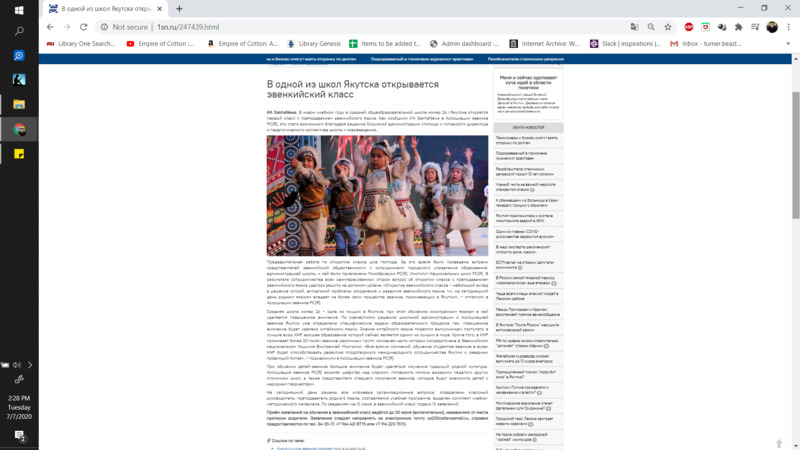
2020-06-16
"In the new academic year, the first class with the teaching of the Evenki language will open in secondary school number 26 in Yakutsk. As the Evenki Association of RS (Y) told SakhaNews, this was made possible thanks to the decision of the district administration of the capital and the readiness of the school director and teaching staff to innovate."
-
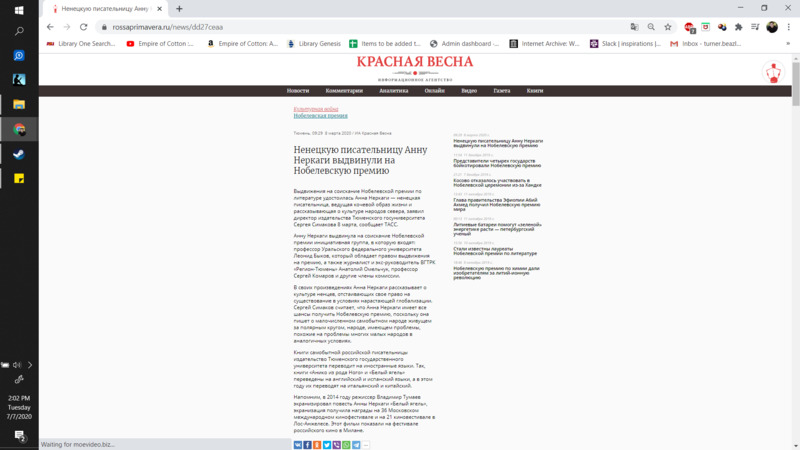
2020-03-08
"Anna Nerkagi, a Nenets writer who leads a nomadic lifestyle and talks about the culture of the peoples of the North, won nominations for the Nobel Prize in literature"
-
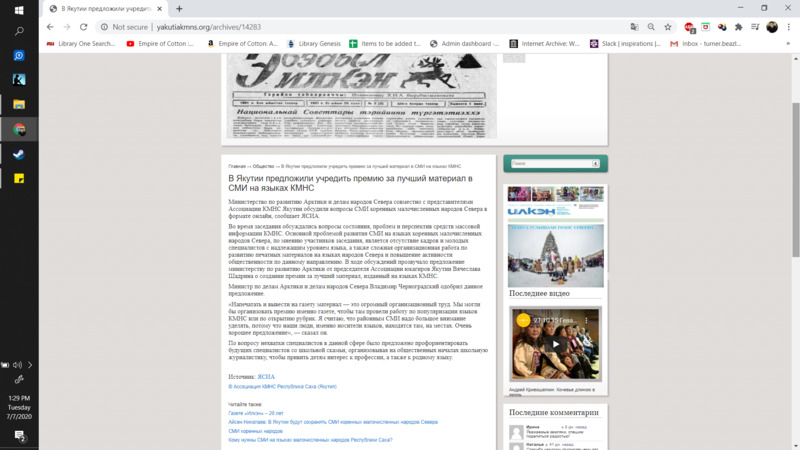
2020-07-03
"During the discussions, a proposal was made to the Ministry of Arctic Development from the chairman of the Association of Yukagirs of Yakutia, Vyacheslav Shadrin, to create an award for the best material published in the languages of the indigenous peoples."
 2021-04-21
2021-04-21 2021-04-20
2021-04-20 2021-04-20
2021-04-20 2021-03-20
2021-03-20 2020-10
2020-10 2021-01-24
2021-01-24 2021-01-24
2021-01-24 2020-09-09
2020-09-09 2020
2020 2020-12-01
2020-12-01 2020-08-21
2020-08-21 2020-07-04
2020-07-04 2020-08-05
2020-08-05 2020-08-11
2020-08-11 2020-07-29
2020-07-29 2020-06-01
2020-06-01 2020-05-11
2020-05-11 2020-06-05
2020-06-05 2020-06-01
2020-06-01 2020-06-03
2020-06-03 2020-07-13
2020-07-13 2020-07-02
2020-07-02 2020-05-28
2020-05-28 2020-07-30
2020-07-30 2020-05-15
2020-05-15 2020-07-06
2020-07-06 2020-05-15
2020-05-15 2020-03-24
2020-03-24 2020-06-12
2020-06-12 2020-06-15
2020-06-15 2020-06-18
2020-06-18 05/11/2020
05/11/2020 2020-07-13
2020-07-13 2020-07-10
2020-07-10 2020-06
2020-06 2020
2020 2020-06-10
2020-06-10 2020-06-10
2020-06-10 2019-06-04
2019-06-04 2020
2020 2020-06-23
2020-06-23 2020-06-23
2020-06-23 2020-06-09
2020-06-09 2020-06-17
2020-06-17 2020-06-28
2020-06-28 2020-06-27
2020-06-27 2020-06-16
2020-06-16 2020-03-08
2020-03-08 2020-07-03
2020-07-03